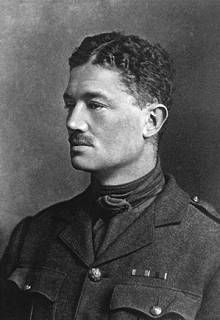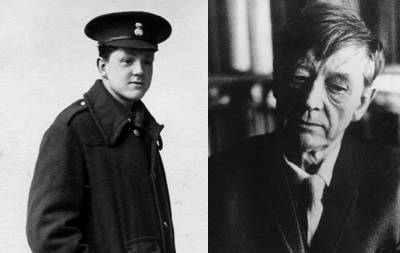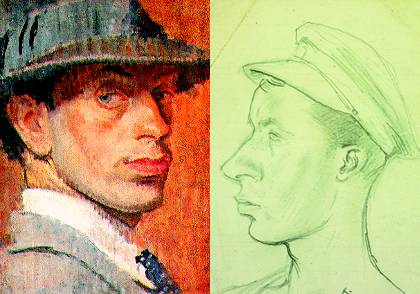|
<< -- 4 -- Roderic Dunnett BEHIND THE LINES

Five others of the poets featured -- Grenfell, Ledwidge, Thomas, Rosenberg
and Owen -- were killed. By contrast the composer-poet Ivor Gurney, who is
of especial interest to musicians, survived by two decades, but spent fifteen
years in an asylum (he himself had virtually foreseen this in his war poem
Ballad of the Three Spectres). Rupert Brooke died of infection and
blood poisoning en route to the Dardanelles. Only four (Sassoon,
David Jones, Edmund Blunden and Robert Graves), marched on to a ripe old
age, becoming literary giants in their day.

Julian Grenfell portrait. Photo: The Imperial War Museum, London
|
Julian Grenfell, whose family knew Kitchener (as letters between them,
displayed in the Imperial War Museum exhibition, bear witness), and the
only one to become a professional soldier, is known, says Stallworthy, almost
as a one-poem poet (Into Battle) : 'It's a rather savage
and politically incorrect poem, by someone who was a bit of a bloodthirsty
Homeric hero, and who actually admits he enjoyed killing his fellow men.'
Grenfell's letters tend to confirm this : 'I adore war. It is like
a big picnic, without the objectlessness of a picnic. I've never been
so well or so happy.' [read a biography]

David Jones as a young man, and later in life. Photos: The Imperial War Museum, London
|
One who took a rather different view was the Welshman, David Jones. 'I'm
really pleased', Stallworthy observes, 'that we've been able
to include Jones : he's a major figure, whose work is still too little known.
In Parenthesis (David Jones's retrospective war poem, not published
till 1937) is an outstanding work, rooted in Jones's Welsh background' (the
colouring in places could indeed almost be Dylan Thomas) 'but couched in
the Modernist tradition of Eliot' ('You can hear the rat of no-man's-land
... weasel-out his patient workings, scrut, scrut, sscrut ...').

David Jones drawing : dead rats at Ploegsteert, near Ypres. Photo: The Imperial War Museum, London
|
Jones was not just a poet but an artist. So, to a degree, was the aristocratic
Grenfell (his parents, Lord and Lady Desborough, who owned Taplow Court
above the Thames at Maidenhead, were sketched by John Singer Sargent; both
pictures are displayed in the exhibition) and -- more strikingly -- another
of the twelve, Isaac Rosenberg, who like Jones, Gurney, Ledwidge and Edward
Thomas (for more than a year Thomas served as a mere private and NCO; he
was eventually commissioned second lieutenant in the Royal Artillery in
November 1916, and served as an officer in France), served in the ranks;
all the rest were officers.

Isaac Rosenberg sketched self-portrait in France (right) alongside a colour selfportrait. Photos: The Imperial War Museum, London
|
Rosenberg's paintings and sketches (those displayed include a superb
clutch of indisputably Modernist family and self-portraits, in violent colours
to rival Kandinsky or Otto Dix) hold up surprisingly well in the company
of Nevinson and Nash.
Continue >>
Copyright © 26 December 2002
Roderic Dunnett, Malvern, Worcestershire, UK

|

